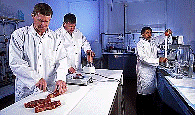United States Department of Agriculture: Agricultural Research Service, Lincoln, Nebraska

Roman L. Hruska U.S. Meat Animal Research Center: Reports
Date of this Version
1993
Document Type
Article
Abstract
Rate of reproduction has a major impact on life cycle costs of production of different animal species and upon their competitiveness for different types of production resources. For example, the average beef cow is capable of producing about .7 of her body weight per year in progeny market weight; comparable values are about 8 in pigs, more than 70 in meat chickens and more than 1,000 in catfish. More than 50% of the feed nutrients used by the beef cattle industry of the United States are needed to meet maintenance requirements of reproducing females. The comparable value in meat chickens is less than 3%. Further, high producing dairy cows produce five times as much milk protein per unit of feed as beef cattle produce as beef protein. Small differences in reproduction rate of beef cattle can have a major effect on costs of production and on the production resources for which beef cattle are competitive. Results from experimentation and computer simulation suggest that input costs per unit of beef output could be reduced by from 20 to 30% for the proportion of the herd that produces twins.
A twinning technology would require a highly intensive production system. Initial calculations indicate that a twinning rate of about 40% may be needed to make a twinning technology economically viable. Because of the time and effort required to develop a population with a twinning frequency of 40% or greater, private sector interests are not likely to make the investment required. Thus, the development of a population of cattle that has a high breeding value for twinning (i.e., 40% or greater) and is competitive in production and carcass traits is an essential component of a twinning technology for use by the beef cattle industry.


Comments
Published in Beef Research Program Progress Report (1993) No. 4 (Part 1): 48-51